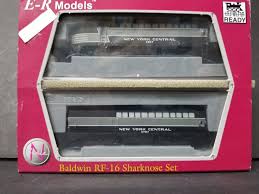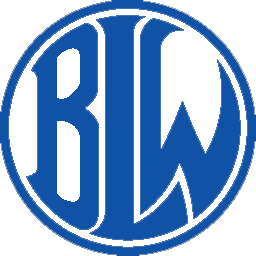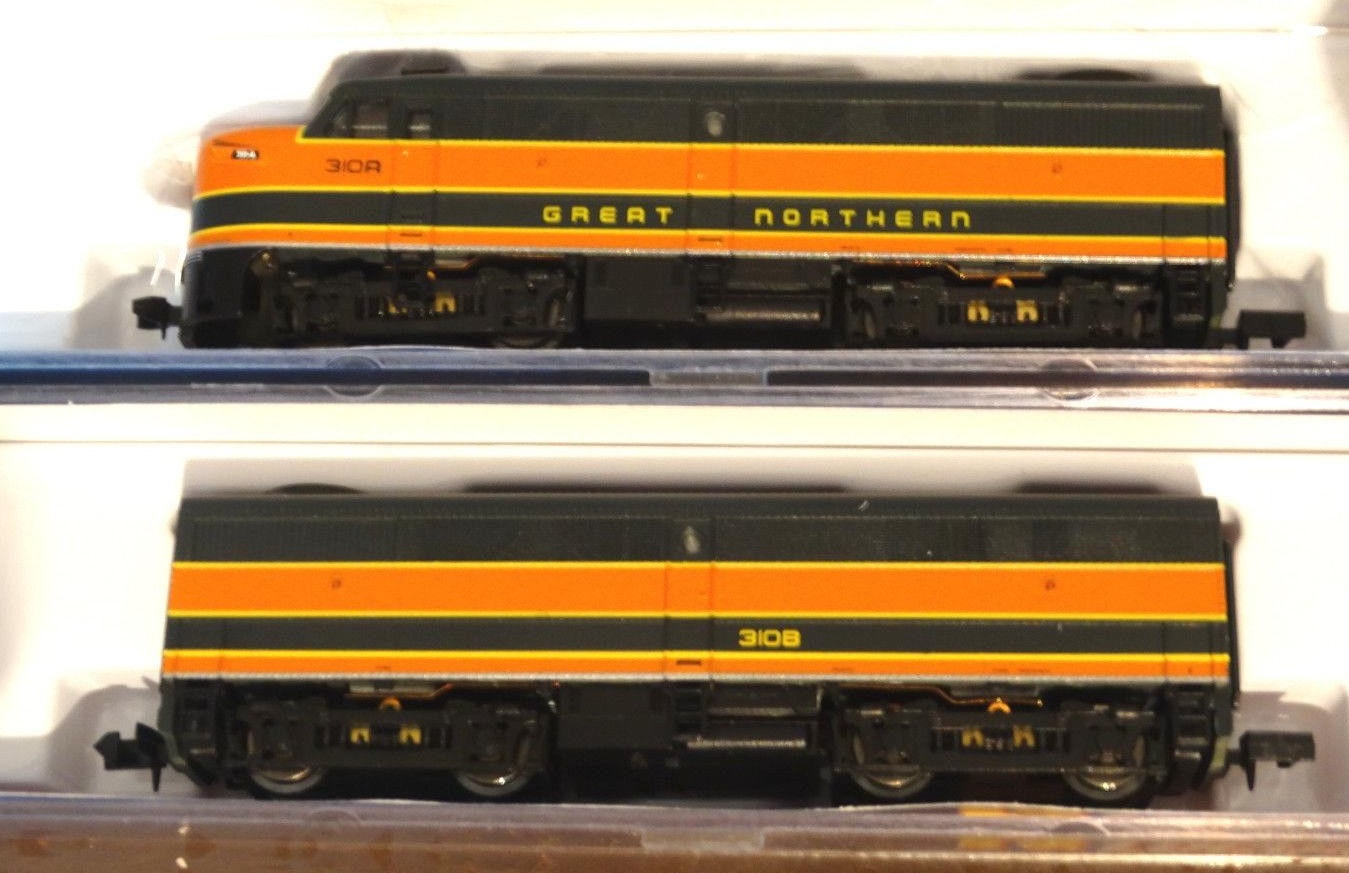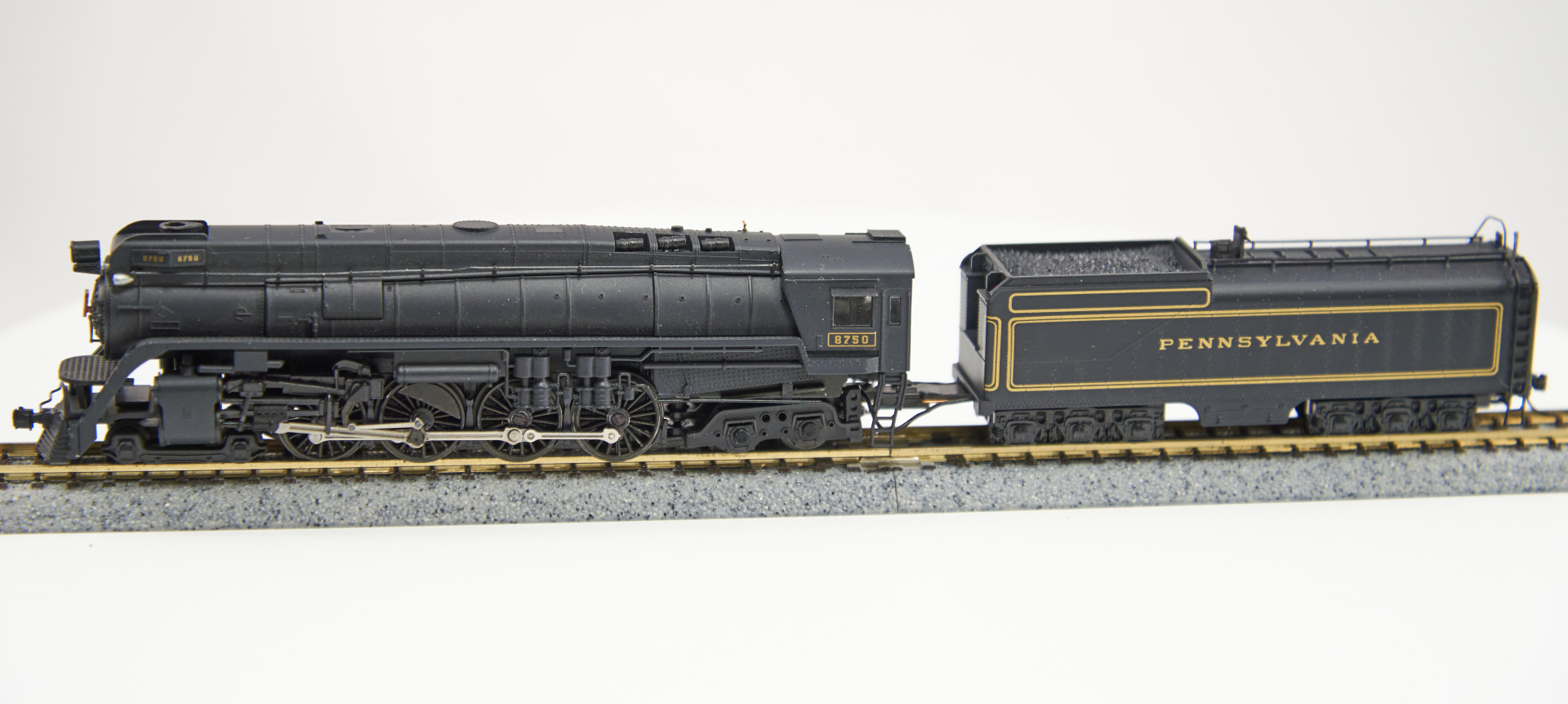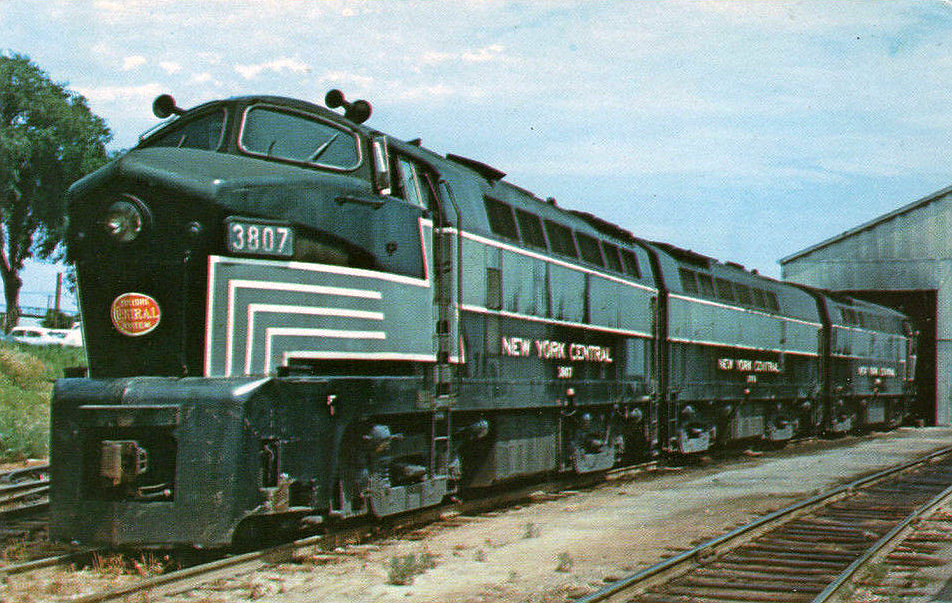Model Information: This model was first launched in 2001. E-R Models of New Jersey contracted with Bachmann/Kader to produce this engine in both N and HO. Like all Bachmann products, these models were made in China. It uses a 5-pole skew-wound motor. The couplers are truck-mounted Rapidos. These are not easy to fit with Micro-Trains, so despite the fact that they run well, they will be a headache to use with modern rolling stock unless you use a gender-bender buffer car (Rapido couplers on one end and MTL on the other).
DCC Information: The model is DCC-Ready, but the only known manufacturer of a decoder for it is Digitrax, and they discontinued production of the decoder that fits this model.
Prototype History: The Baldwin RF-16 was a 1,600-horsepower (1,200 kW) cab unit-type diesel locomotive built for freight service by the Baldwin Locomotive Works between 1950 and 1953. All RF-16s were configured with a B-B wheel arrangement and ran on two AAR Type B two-axle road trucks, with all axles powered. A total of 109 cab-equipped A units were built, along with 51 cabless booster B units, for a total of 160 locomotives built. As was the case with most passenger locomotives of its day, the RF-16s came equipped with a retractable, nose-mounted drop coupler pilot. Unlike competing units from EMD and Alco, the RF-16 used an air-powered throttle, meaning that it could not be run in MU operation with EMD or Alco diesels without special MU equipment.
From Wikipedia
From Wikipedia
Road Name History: The New York Central Railroad (reporting mark NYC), known simply as the New York Central in its publicity, was a railroad operating in the Northeastern United States. Headquartered in New York City, the railroad served most of the Northeast, including extensive trackage in the states of New York, Pennsylvania, Ohio, Michigan, Indiana, Illinois, and Massachusetts, plus additional trackage in the Canadian provinces of Ontario and Quebec.
The railroad primarily connected greater New York and Boston in the east with Chicago and St.Louis in the midwest along with the intermediate cities of Albany, Buffalo, Cleveland, Cincinnati, and Detroit. NYC's Grand Central Terminal in New York City is one of its best known extant landmarks.
1853 company formation: Albany industrialist and Mohawk Valley Railroad owner Erastus Corning managed to unite ten railroads together into one system, and on March 17, 1853 executives and stockholders of each company agreed to merge. The merger was approved by the state legislature on April 2, and by May 17, 1853 the New York Central Railroad was formed.
In 1867 Vanderbilt acquired control of the Albany to Buffalo running NYC. On November 1, 1869 he merged the NYC with his Hudson River Railroad into the New York Central and Hudson River Railroad. Vanderbilt's other lines were operated as part of the NYC.
In 1914, the operations of eleven subsidiaries were merged with the New York Central & Hudson River Railroad, re-forming the New York Central Railroad. From the beginning of the merge, the railroad was publicly referred to as the New York Central Lines. In the summer of 1935, the identification was changed to the New York Central System.
In 1968 the NYC merged with its former rival, the Pennsylvania Railroad, to form Penn Central (the New York, New Haven and Hartford Railroad joined in 1969). That company went bankrupt in 1970 and was taken over by the federal government and merged into Conrail in 1976. Conrail was broken up in 1998, and portions of its system was transferred to the newly formed New York Central Lines LLC, a subsidiary leased to and eventually absorbed by CSX and Norfolk Southern. Those companies' lines included the original New York Central main line, but outside that area it included lines that were never part of the New York Central system. CSX was able to take one of the most important main lines in the nation, which runs from New York City and Boston to Cleveland, Ohio, as part of the Water Level Route, while Norfolk Southern gained the Cleveland, Ohio to Chicago, Illinois portion of the line called the Chicago line.
At the end of 1925, the New York Central System operated 11,584 miles (18,643 km) of road and 26,395 miles (42,479 km) of track; at the end of 1967 the mileages were 9,696 miles (15,604 km) and 18,454 miles (29,699 km).
Read more on Wikipedia.
The railroad primarily connected greater New York and Boston in the east with Chicago and St.Louis in the midwest along with the intermediate cities of Albany, Buffalo, Cleveland, Cincinnati, and Detroit. NYC's Grand Central Terminal in New York City is one of its best known extant landmarks.
1853 company formation: Albany industrialist and Mohawk Valley Railroad owner Erastus Corning managed to unite ten railroads together into one system, and on March 17, 1853 executives and stockholders of each company agreed to merge. The merger was approved by the state legislature on April 2, and by May 17, 1853 the New York Central Railroad was formed.
In 1867 Vanderbilt acquired control of the Albany to Buffalo running NYC. On November 1, 1869 he merged the NYC with his Hudson River Railroad into the New York Central and Hudson River Railroad. Vanderbilt's other lines were operated as part of the NYC.
In 1914, the operations of eleven subsidiaries were merged with the New York Central & Hudson River Railroad, re-forming the New York Central Railroad. From the beginning of the merge, the railroad was publicly referred to as the New York Central Lines. In the summer of 1935, the identification was changed to the New York Central System.
In 1968 the NYC merged with its former rival, the Pennsylvania Railroad, to form Penn Central (the New York, New Haven and Hartford Railroad joined in 1969). That company went bankrupt in 1970 and was taken over by the federal government and merged into Conrail in 1976. Conrail was broken up in 1998, and portions of its system was transferred to the newly formed New York Central Lines LLC, a subsidiary leased to and eventually absorbed by CSX and Norfolk Southern. Those companies' lines included the original New York Central main line, but outside that area it included lines that were never part of the New York Central system. CSX was able to take one of the most important main lines in the nation, which runs from New York City and Boston to Cleveland, Ohio, as part of the Water Level Route, while Norfolk Southern gained the Cleveland, Ohio to Chicago, Illinois portion of the line called the Chicago line.
At the end of 1925, the New York Central System operated 11,584 miles (18,643 km) of road and 26,395 miles (42,479 km) of track; at the end of 1967 the mileages were 9,696 miles (15,604 km) and 18,454 miles (29,699 km).
Read more on Wikipedia.
Brand/Importer Information:  E-R (Euro-Rail) Models was based at 1000 South Main Street in Newark, New York. The owner's name is Al Muniz. They produced reprints of various models using toolings discarded by Atlas (and possibly other manufacturers). They also produced their own locomotive, the Baldwin RF-16 Sharknose. The model was manufactured by Bachmann in China. E-R filed for bankruptcy in 2001.
E-R (Euro-Rail) Models was based at 1000 South Main Street in Newark, New York. The owner's name is Al Muniz. They produced reprints of various models using toolings discarded by Atlas (and possibly other manufacturers). They also produced their own locomotive, the Baldwin RF-16 Sharknose. The model was manufactured by Bachmann in China. E-R filed for bankruptcy in 2001.

Item created by: gdm on 2018-01-23 15:30:46. Last edited by gdm on 2020-07-24 07:29:17
If you see errors or missing data in this entry, please feel free to log in and edit it. Anyone with a Gmail account can log in instantly.
If you see errors or missing data in this entry, please feel free to log in and edit it. Anyone with a Gmail account can log in instantly.


